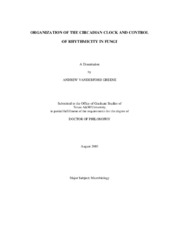| dc.description.abstract | Circadian rhythms in biological processes occur in a wide range of organisms and are generated by endogenous oscillators. In Neurospora crassa, the FRQ-oscillator (comprised of FRQ, WC-1 and WC-2) is essential for rhythms in asexual sporulation and gene expression. How this oscillator signals to the cell to control rhythmicity is unknown. Furthermore, under certain growth conditions, rhythms are observed in FRQ-null strains, indicating the presence of one or more FRQ-less oscillators (FLOs). Interestingly, while circadian rhythms are observed in the related Aspergillus spp., they lack the frq gene, leading to the hypothesis that a FLO is responsible for rhythms in Aspergillus. Thus, Aspergillus provides a useful organism to investigate the components of the FLO. To investigate how an oscillator controls circadian output, we characterized the role of N. crassa NRC-2. The nrc-2 gene is under control of the clock and encodes a putative serine-threonine protein kinase. In a NRC-2-null strain cultured in low glucose conditions, FRQ-oscillator-dependent outputs are arrhythmic, but are rhythmic in high glucose. Our data suggests a model whereby NRC-2 relays metabolic information to the FRQ-oscillator to control rhythmic output. To understand the role of FLO(s) in the N. crassa circadian system, we examined regulation of the ccg-16 gene. We show that ccg-16 transcript rhythmicity is FRQ-independent, but WC-1-dependent. Furthermore, in contrast to current models for the FRQ-oscillator, we observed that rhythms in WC-1 protein accumulation persist in the absence of FRQ. These data support a new model involving two oscillators that are coupled through the WC-1 protein and that regulate different outputs. One approach to identify components of the FLO involved characterizing circadian rhythms in Aspergillus spp, which lacks FRQ. We find that A. flavus and A. nidulans, display circadian rhythms in sporulation and gene expression, respectively. Together, these findings provide a foundation for the identification of FLO components in both Aspergillus and N. crassa, that will ultimately lead to an understanding of how a multi-oscillator system can generate and coordinate circadian rhythmicity. | en |


